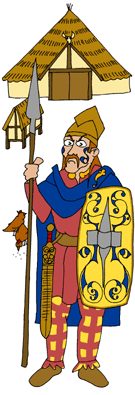|
RBH Home
Maps & Travels
Articles
Legends
Towns & Villages
Castles & Houses
Churches
Biographies
Gentry
Family History
Odds & Ends
For Kids
Teacher's Page
Mail David

|
|

in the Berkshire part of the Thames Valley

|
- Before Saxon
times, Berkshire did not exist; but there
were always people living and working in the same area, the Valley of
the River Thames.
- People first came to live there
around 10,000 years ago, in the Stone Age. Much of the area was then
covered by woodland and was good for hunting animals to eat.
- They moved around the area on
tracks like the Icknield Way and the Ridgeway. Some of
the earliest hunters lived near Thatcham
and Kintbury.
- About 6,000 years ago the people
started to cut down some of the trees and set up farms. They buried
their dead in stone chambers (rooms) under long mounds called 'long
barrows'. There is one at Inkpen, one at Lambourn and a famous one at
Ashbury called 'Wayland's Smithy'.
- About 1,000
years later, people started to use Bronze to make tools and weapons.
Hoards (buried collections) of bronze axes have been found at
Yattendon and Ashbury. The famous Moulsford Torc (a neck ring) also dates from this
time, but that was made of gold.
- Archaeologists have found the
remains of villages from this 'Bronze Age' in Berkshire. The people
lived in small thatched round houses and some chiefs built small hillforts
like Uffington Castle and Ram's Hill (both in Uffington).
- We don't know much about their
religion, but they did carve a big White
Horse into the hillside at Uffington and seem to have worshipped
their dead ancestors.
- They buried their dead under
round mounds (called 'barrows') - like the famous 'Seven Barrows' at
Lambourn. The biggest one in Berkshire is at Finchampstead. It is 30
metres in diameter.
- Sometimes these were built near a cursus. This was a very
long enclosure with a big earth bank and ditch. It was probably used
for religious ceremonies. There was one at Drayton, near Abingdon.
- About 3,000 years ago, people
started using iron instead of bronze. This period is called the 'Iron
Age'.
- Houses were
still thatched and round, but bigger. The people worshipped many pagan
gods and adopted
Celtic
ways. They seem to have thrown their dead and their weapons in the River!
- Some Iron Age chiefs built or
enlarged hillforts with big banks and ditches. They kept people and
food stores safe in times of war. There were 22 hillforts across the
county.
- In the 1st century bc, lots of
people from a Celtic tribe called the Belgae fled from Northern Gaul
(France) to Southern Britain. They had been fighting the Roman
Emperor, Julius Caesar.
- A group called the Atrebates (pronounced At-ree-bart-ays)
settled in the Thames Valley and down towards the South Coast. Their Royal village was at Silchester. It was
called 'Calleva' in those days. This is now just over the county
boundary in Hampshire. They had
a famous king called Verica.
|
Click to find out What
happened Next
|



